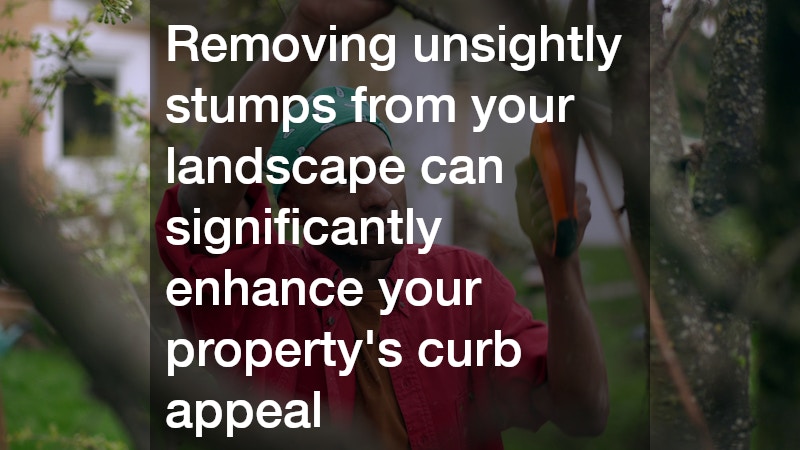Stump grinding is an important procedure that many property owners overlook. Understanding its benefits can foster better property management and enhance the aesthetic appeal of your landscape. Learn more about why stump grinding is essential for your property.
What Is Stump Grinding and How Is It Done?
Stump grinding is a process that involves the removal of tree stumps by grinding them down to below the soil level. This is typically done using specialized machinery known as stump grinders, which can vary in size and capability depending on the job’s needs. Professional arborists, landscapers, or tree removal services usually perform stump grinding, ensuring that the procedure is carried out efficiently and safely.
The stump grinder includes sharp, rotating blades that chip away at the stump, reducing it to small wood chips and mulch. This equipment is designed to be maneuverable, allowing it to access stumps in tight spaces or uneven terrains. Skilled operators know how to use this equipment effectively, maximizing its benefits while minimizing potential damage to the surrounding environment.
In addition to the grinder, safety gear is essential during the stump grinding process, including goggles, gloves, and protective clothing to safeguard the operator from flying debris. After the grinding process, the area is typically left clear of major obstacles, making it easier for property owners to fill the hole with soil or use it for planting other vegetation.
Why Is Stump Grinding Important for Property Value?
Removing unsightly stumps from your landscape can significantly enhance your property’s curb appeal. A clean and tidy yard is more welcoming, and potential buyers are often deterred by the presence of unsightly stumps. By improving the visual appeal, stump grinding plays a direct role in increasing the likelihood of attracting buyers should you ever decide to sell your property.
Moreover, stumps can signal neglect, leading to negative perceptions about the property’s maintenance. When prospective buyers see that stumps have been ground down and the landscape is well-managed, it sets a positive tone about the property’s overall condition. This perception can influence the selling price and speed of sale.
In addition to aesthetics, stump grinding can lead to long-term value retention. By preventing future issues related to decaying stumps—like pest infestations or diseases spreading to healthy trees—you’re safeguarding your property’s value over time. A well-maintained landscape is an investment that pays dividends in property appreciation.
What Are the Benefits of Stump Grinding Over Removal?
Stump grinding offers many advantages when compared to traditional stump removal. Unlike removal, which often involves digging up not just the stump but also extensive root systems, grinding focuses solely on the visible portion of the stump. This minimizes disruption to your landscape and allows for faster recovery.
Another key benefit is cost-effectiveness. Stump grinding is generally less expensive than complete stump removal, mainly due to the reduced labor and time involved. This can be attractive for property owners looking to manage costs effectively while still addressing the issue of unwanted tree stumps.
Furthermore, stump grinding preserves the surrounding landscape, avoiding significant disruptions to other vegetation. Since the roots remain largely intact, existing plants and trees suffer less stress, maintaining their health and aesthetic appeal. This method supports landscape continuity and minimizes the need for extensive replanting.
How Does Stump Grinding Affect the Surrounding Environment?
Leaving stumps intact can create a conducive environment for pests such as termites and carpenter ants. These pests can invade not only the stump but also spread to nearby structures or trees, creating a larger pest management problem. By grinding the stumps down, you can significantly reduce the risk of pest infestations.
Additionally, decaying stumps can lead to fungal growth that affects soil health. This can disrupt the nutrient balance necessary for other plants to thrive in your landscape. Stump grinding eliminates this decaying matter and helps maintain healthy soil, promoting better growth for surrounding vegetation.
Finally, the wood chips produced from stump grinding can be repurposed as mulch. This not only reduces waste but also provides nutrients back to the soil. Using this mulch around other plants can help retain moisture, suppress weeds, and protect against temperature fluctuations, enhancing the health of your garden over time.
When Is the Best Time to Schedule Stump Grinding?
The timing for scheduling stump grinding can play a critical role in its effectiveness. Ideally, stump grinding is best performed during the late winter or early spring, before new growth starts. This timing helps with the quicker recovery of the surrounding landscape, allowing you to implement other landscaping projects effectively.
Scheduling stump grinding after rainfall can also be beneficial, as moist soil is easier to work with and helps keep dust down during the grinding process. However, too much rain can create muddy conditions, complicating access for equipment and potentially damaging your yard.
Lastly, property owners should avoid scheduling stump grinding during high-demand seasons in landscaping, particularly in the summer and fall. During these times, tree services may be busy with other jobs, and you might face delays. Planning ahead ensures your stump grinding is completed in a timely and efficient manner.
Stump grinding is a crucial aspect of property maintenance. By addressing the presence of tree stumps, property owners can leverage numerous benefits that contribute to the overall health and aesthetic of their landscape. Understanding the process, its value, and environmental implications empowers property owners to make informed decisions that will enhance their property value and appeal.

